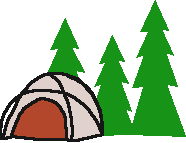Camping and Backpacking With Raw

*NEW* Check out Kona the Raw-fed Camping
Kitty!!!
When camping
or backpacking with raw, feasibility and safety are
always concerns. If there are bears and other carnivorous or omnivorous
wildlife in the area you are going to, it may not be the best idea to
bring fresh meat with you. With a little foresight and planning,
feeding raw while camping or backpacking can be easily managed. Here
are some suggestions.
BACKPACKING
~Feed several large meals in the days preceding the backpacking trip.
This can then be compensated by feeding less during the course of the
trip.
~Pack one frozen raw meaty bone meal to give your pet the evening you
arrive at your backpacking destination. Make sure it is something you
KNOW your dog agrees with. If your pet doesn't want to eat it for some
reason, it is highly recommended that you try again later or cook it
for your own meal.
~You can pack things like dried muscle meat and bully sticks (dried
bull penises; also known as macho stix). The only proviso is that you
feed these things at some point before you go on the trip to make sure
they agree with your dog and won't cause problems.
~Pack a couple cans of canned fish (yes, it adds to the weight load,
and yes, you have to pack the tins out and pack a can opener of sorts,
but they are a quick and easy meal) like canned mackerel or salmon. If
you don't have a collapsible travel dish (which is recommended for
water), just use a paper plate or a flat rock to put the fish on.
~If you are going to fish while backpacking, catch some for your
dog,
too! Fresh fish will be a delicious meal. Just make sure to check the
mouth, throat, and stomach for fish hooks before feeding, and cut off
any spines that may be present on the fish.
Do not feed your dog fresh Pacific salmonids like salmon and trout.
~You can look into getting a few freeze-dried raw meals for your pet;
these can be expensive, and it might actually be more worthwhile to
share your own meals with your pet.
~Eggs can also be packed in, and these make a delicious meal. There are
plastic egg-holders that are fairly effective in protecting the eggs
from being broken.
Try not to resort to feeding kibble, as this is only a quick fix
and it
can cause quite a few problems in a raw fed dog. Being in the middle of
nowhere and having a dog that has diarrhea, is vomiting, is
constipated, or is bloating (which is life-threatening) because of
eating kibble instead of raw food can make for a very short and
unpleasant trip (not to mention the fact that squirrels and other
critters LOVE kibbled dog food, and that the kibble can quickly become
rancid and moldy given the proper weather conditions).
CAMPING
Camping allows
you more flexibility in what you can bring for your
pet's food. Food can generally be contained in ice chests or may even
be bought at a store or market nearby.
~Pack an ice chest full of your dog's foods. Make sure all the raw
meaty bones are completely frozen, and layer them over regular ice or
dry ice to keep them frozen. Ideally the meat will start to thaw in
different stages and you can feed whatever is becoming thawed. Exercise
caution in where you keep this ice chest. In some campgrounds, bears
are known to "break into" cars to get food inside. In other
campgrounds, if bears don't see anything that looks like an ice chest,
they keep on moving. Either way, don't leave the ice chest out in the
open, and make sure you keep the area clean so that the meat won't
attract any unwanted visitors.
~Pack canned fish, dried meat strips, and bully sticks (if these all
agree with your dog) to give your dog as a treat or in a pinch should
you run out of raw meaty bones.
~Eggs are an excellent meal, and can easily be packed in one of
those
plastic egg carriers.
~If you are camping for an extended period of time (several weeks) and
do not want to bring that many raw meaty bones and whole carcasses for
your pet, locate markets around the area that would carry meat. Then
you can stock up whenever needed. However, the meat may be more
expensive than you are used to and there may be less variety as well.
~Look into having whole animals like rabbits shipped directly from
suppliers to the campground to supplement your RMB supply.
OTHER
LOGISTICS
If you don't want your dog eating on the dirt or ingesting dirt
particles, small rocks, etc. with its meaty bones, then purchase a
plastic dropcloth or cheap, plastic-like tablecloth. Spread this
out at each meal, let the dog eat on it, and then wipe it clean.
If you are having problems with wasps or think you might have problems
with wasps, look into purchasing some mosquito netting that you can
'rig' over your dog's eating area like a tent. Other alternatives
to the netting would include citronella candles and insect-repelling
incense sticks that smoke, but both of these products may prove to be
rather irritating to a dog's sensitive nasal passages (and can be
downright toxic!). If you are
camping and are bringing your dog's kennel, consider feeding the dog in
the kennel with mosquito netting draped over it. If you aren't
bringing a kennel, consider looking into purchasing a relatively
light-weight traveling kennel that is made from nylon or canvas
material. The windows and entrance of these kennels are already
netted.
If you are camping or backpacking with other friends who have dogs, try
to find a secure eating area for your pet so that it won't be pestered
by other animals while it eats (and so no fights ensue; most
dogs--kibble fed or not--won't permit other dogs to approach their food
dish while they are eating, so it is not just a "raw feeding
problem"). This may mean you feed your dog in the back of a
pickup, or in its kennel, or in your tent or an exercise pen (if you
happen to lug one along). Or your friends may have to tie up
their dogs; everyone can feed their dogs at the same time and leash
them all out of reach of each other.
Be creative, and don't be discouraged by the "difficulty" in camping or
backpacking with a raw-fed pet. Where there is a will, there's a way.
Yes, you must be more creative in feeding your pet, and you might have
to dedicate more time to planning ahead for your pet than before, but
the rewards of a happy, healthy, raw-fed animal far outweigh the
difficulties. Be flexible and open to trying new ideas. Happy trails!
 BACK TO
FEEDING GROUND MYTH
BACK TO
FEEDING GROUND MYTH



